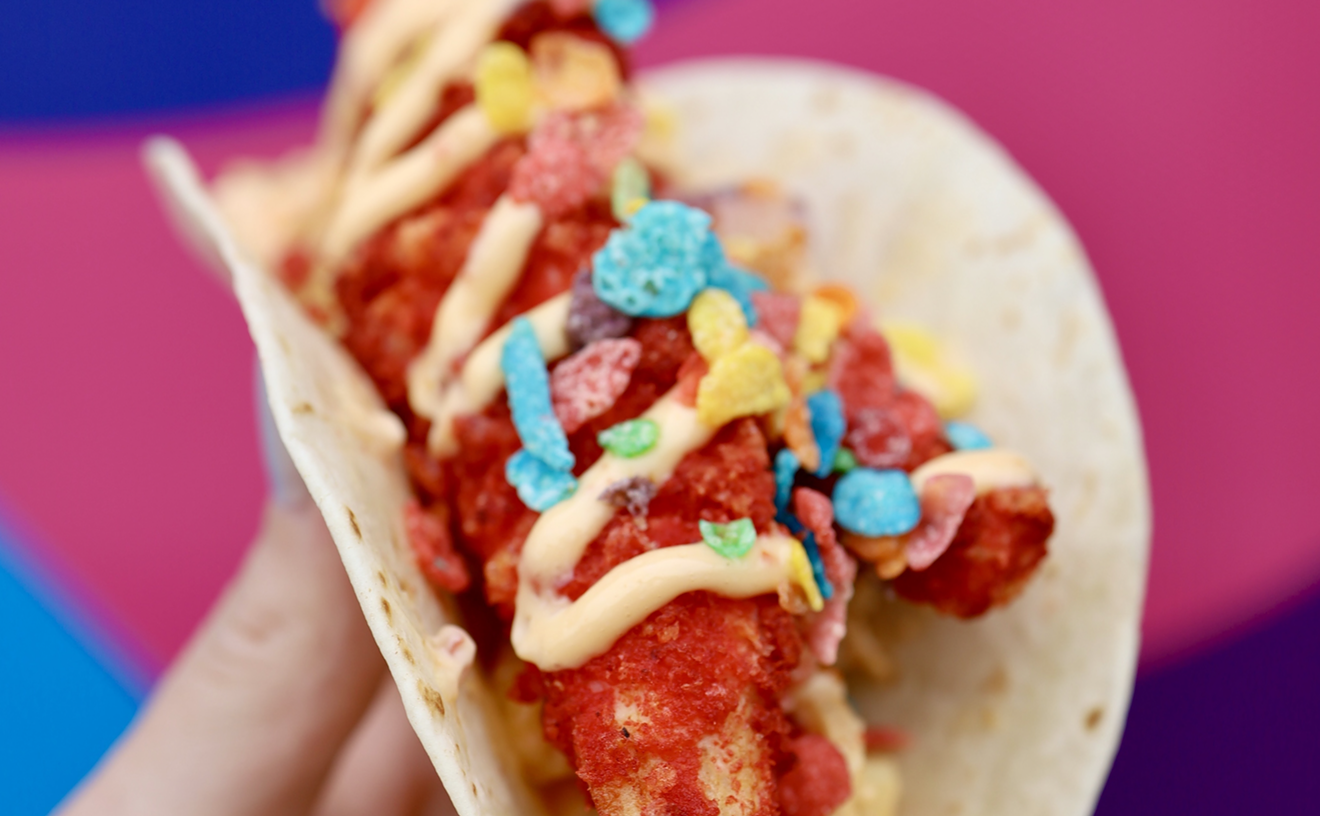As construction crews toiled away in the yawning, gilded space that houses Pao by Paul Qui, owners of the Faena Hotel Miami Beach were fixated on centerpiece art for the dining room. "One of the funniest conversations with them was about seriously asking Damien Hirst to create another mammoth, but one that was lighter and could fit in the middle of the room," Qui says, referring to the hotel's hulking gold statue that overlooks the ocean. "In my mind I'm thinking, Man, these people are crazy."
If there's any left over, don't allow servers to whisk it away.
tweet this
In the end, Argentine developer Alan Faena and partner Len Blavatnik settled on a $6 million golden unicorn statue Blavatnik nabbed during a charity auction in Saint-Tropez. Since the restaurant opened in late 2015, the beast has inspired not only chatter but also an over-the-top dish at the 140-seater. The vessel for this dramatic affair is a sea urchin shell with bristling spines. Inside is a luxurious sweet corn pudding spiked with chile de árbol and refreshed with kalamansi. A firm lobe of Santa Barbara sea urchin adds a bit of excess, helping justify the $26 cost.
The unicorn also inspired a $25 cocktail that arrives in a solid copper goblet that a waiter says costs about $500. Inside lurks an intoxicating slurry that's part Moscow mule and part piña colada. A dash of ginger juice helps counter the sugar, tamps down the vodka's sting, and rounds off each swig with delicate freshness.
The 36-year-old Qui has had major ups and downs in his young career. In 2011, he won the ninth season of the reality cooking show Top Chef and was named Best Chef Southwest by the James Beard Foundation the following year. This past March, Qui was arrested in Austin, Texas, after police responded to a disturbance-with-violence call. According to the arrest affidavit, Qui went into a drug-and-alcohol-induced rage. He later checked himself into a rehab clinic yet still faces two misdemeanor charges carrying penalties of $4,000 or up to a year in jail.
His Miami Beach restaurant is his first outside of Austin, where he owns a half-dozen spots that survey Asian cuisine with a focus on his native Philippines. Many are humble places that began as food trucks. He was lured to Miami by the extensive resources and freedom the Faena offered.
All of the excess comes with a hefty price tag. It's not hard to rack up a $250 tab here. Meanwhile, Qui is enthralled with not only sea urchin and foie gras but also simple ingredients such as fried chicken and pork shoulder. The result is a meal that could leave some patrons feeling shortchanged. That's sad. Qui and his chef de cuisine, Derek Salkin, constantly tinker with the two-page menu to create unique combinations of flavors and ingredients.
Case in point: A pair of fat diver scallops from Cape Cod is grilled over binchotan charcoal and then lacquered with savory matsutake mushroom butter. The outside of the bivalve bears a golden crust, while its interior remains a creamy treat. An ingenious combination of razor-thin mushrooms, green apple, and kohlrabi adorns the plate with freshness. Delicate spots of an ultraherbaceous pine oil multiply each bite's encapsulation of the sea.
Then there's a dish deceivingly labeled "gnocchi." In reality, it's a riff on the Filipino pork blood stew called dinuguan in which the pig's ichor is cooked off with pork stock, vinegar, and sweet and spicy peppers. The result is a thick, luscious sauce with an assertive, meaty flavor devoid of offal notes. Puffy gnocchi, perhaps the best being rolled at the moment, pinch-hit for the steamed rice bread called puto that usually comes with this stew. And don't forget the addictive pig ear shreds scattered across the plate for a snappy crunch.
Other dishes aren't as well done. A crudo of the lean, raw tuna called akami topped with Castelvetrano olive bits in a pool of olive oil and sweetened balsamic vinegar is too acidic. Whatever elegance there might be in these flavors is lost in the pungency. A shallow bowl of grilled greens is also underwhelming. The red lettuces and radicchio bear only a hint of char. There's also little of the promised pine nut praline, green apple, or charred onion sour cream that would've helped push the dish beyond an underdressed side salad.
A similar plate of vegetables burnished with smoky grill marks arranged around a velvety pool of the Filipino condiment sarsang talong is better. Tender yet toothsome carrots, squash, radish, and zucchini pieces are flecked with mint and form a crescent moon shape around the smooth purée of eggplant, vinegar, and garlic. If there's any left over, don't allow servers to whisk it away. They will try. Staff here is attentive and skillfully helps course out what would otherwise be an onslaught of food.
They are also adept at explaining the menu. One warns about how the East Side King fried chicken — a dish Qui transplanted from one of his food trucks — is brined in fish sauce. No matter. The funky fermented concoction imparts each crisp bite with a depth of flavor that hasn't been experienced since GastroPod's chef Jeremiah Bullfrog stopped brining his chicken in gochujang, a fermented Korean chili paste.
Chicken is also the most reasonable way to get your fill here. Among the quartet of large plates, which includes a $95 half lamb saddle and a $90 pork shoulder, the $32 Green Circle chicken from Pennsylvania's Amish country is your best bet. The bird is brined for several hours before undergoing a slow smoke over applewood. After a quick roast to crisp the fragrant yellow skin, it's glazed with a sweet-savory soy caramel. When it arrives, a server pours a rich chicken fat emulsion over the accompanying garlic-ginger rice. Not a grain will be left over.
Four rice options provide a pleasant way to cap a meal. The lone cold choice is a chirashi made with whatever fish the kitchen has on hand that week. Recently, it was fatty and lean tuna, hiramasa (also known as yellowtail amberjack), and the Japanese sea bream called madai. Most slices present a clean, bright flavor — though a few pieces of tuna seemed to be cut too close to the bloodline, giving them a fishy, oily bite.
Given the dish's $39 price tag, most diners might not have patience for such missteps. However, the chirashi's rice is spot on, and the lump of vibrant salmon roe is comparable only to the stuff occasionally found at Kevin Cory's Naoe. Qui admits the pricing is steep but notes he and Salkin are constantly working to change the menu to ensure everyone walks away satisfied.
Pao by Paul Qui
3201 Collins Ave., Miami Beach; 786-655-5630; faena.com. Dinner Sunday through Thursday 6 to 11 p.m., Friday and Saturday 6 p.m. to midnight.
Unicorn, $26
Maguro and olives, $22
Grilled greens, $14
East Side King chicken, $15
Gulay, $12
Diver scallops, $32
Gnocchi, $24
Smoked heritage chicken, $32/$55
Chirashi, $39











